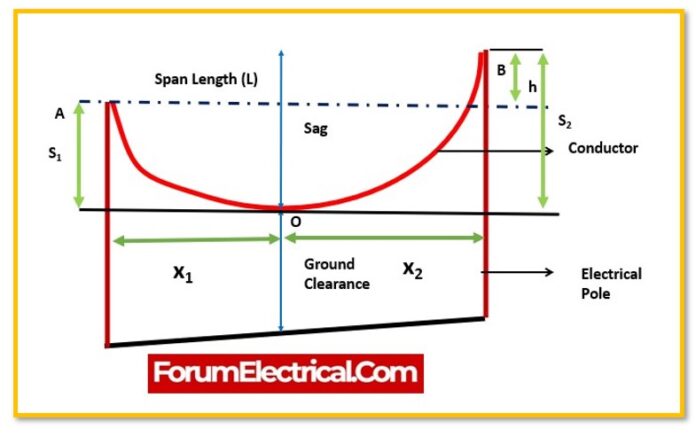What is Sag in an Electrical Transmission Line?
Sag in a transmission line is the vertical distance that exists between the highest and lowest points of the support structures (often transmission towers) and the conductor. The length of the transmission line’s overhead conductor is a key factor in determining sag and tension.
A level span is one that has supports that are all at the same level, or towers that are all the same height. On the other hand, a span is said to have uneven level span when the support levels at different points along the span are not equal.
Imagine a conductor for a transmission line labelled AOB that is freely hanging between two level supports labelled A and B that are at the same level (equal span). The conductor takes the form of a parabola, and its lowest point, denoted by the letter O, is located on the conductor.

When measured in a vertical orientation, the sag of the overhead conductor AOB is denoted by the letter S.
Conductor Sag and Tension
- Conductor sag and
- Tension
are two essential factors that require to be taken into consideration during the structural design of overhead wires. The measure of sag in the conductor should be maintained to a minimum in order to cut down on the amount of material needed for the conductor and to prevent adding additional pole height for suitable clearance above the ground level.
It is also preferable that the tension in conductor be low in order to prevent the conductor from failing mechanically and to make it possible to make use of supports with a lower overall strength.
However, low conductor tension & minimal sag are not possible with this design. This is due to the fact that a high tension corresponds to a tight wire & a low sag, while a low tension corresponds to a loose wire & an increased sag.
As a result, in normal circumstances, an arrangement that achieves a balance between the conductor sag and tension .
What are the Reasons for the requirement of Sag in Transmission (OHT) Line Conductors?
In the suspension of transmission line conductors, sag is always required. Conductors are usually fixed in place between two supports that have the appropriate amount of sag.
This is due to the fact that it shields the conductor from an abnormally high stress. Instead of being totally stretched, conductors are permitted to have some sag in them so that a safe amount of tension may be maintained in the conductor. This is done for safety reasons.
If the conductor is completely stretched out while it is being installed, the wind will apply pressure to the conductor, which increases the possibility that the conductor may be damaged or get disconnected from its end support. As a result, sag is permitted during the conductor suspension.
Some essential factors to note:
- When the conductor is held by the same two supports at the same level, it tends to take on a bent form. In comparison to the span of the conductor, sag is not particularly significant.
- The curve that represents the Sag span is parabolic.
- At every given position along the conductor, the tension always acts in a tangential pattern.
Sag Calculation
1). When support are at equal level
S = wL2/8T
Where,
S – Conductor Sag
L – Span length
w – Weight of the conductor and
T – Tension of the Cable

2). When support are at unequal level
S1 = wx12/2T and S2 = wx22/2T

And x1 + x2 = L
By Solving the equation,
x1= L/2 – Th/wL
x2= L/2 + Th/wL
From the value of x1 and x2, S1 and S2 can be determined.
Where,
h -Level Difference between two supports
x1 – Distance of support -lower level A from O
x2- Distance of support -higher level B from O
S1 and S2 – Span Length
Factors affecting Sag
1). Conductor weight
2). Span
Sag is proportional to the square of the length of the span. More sag results from a longer span.
3). Tension
Sag is inversely proportional to conductor tension. Higher tension stresses the insulators & supporting structures.
4). Wind
Wind causes sag to rise in the sloped direction.
5). Temperature
At low temperatures, sag is lowered; at high temperatures, sag increases.
How is it possible to prevent a transmission line from sagging?
The stringing blocks, when they are suspended on the transmission structure for sagging, need to be set in such a way that the conductor on the span will be at the same level of height as the suspension clamp to which is secured.
This is necessary to prevent the conductor from being damaged. At extreme vertical angles, the sags & tension must be examined on both the vertical sides of the angle.









